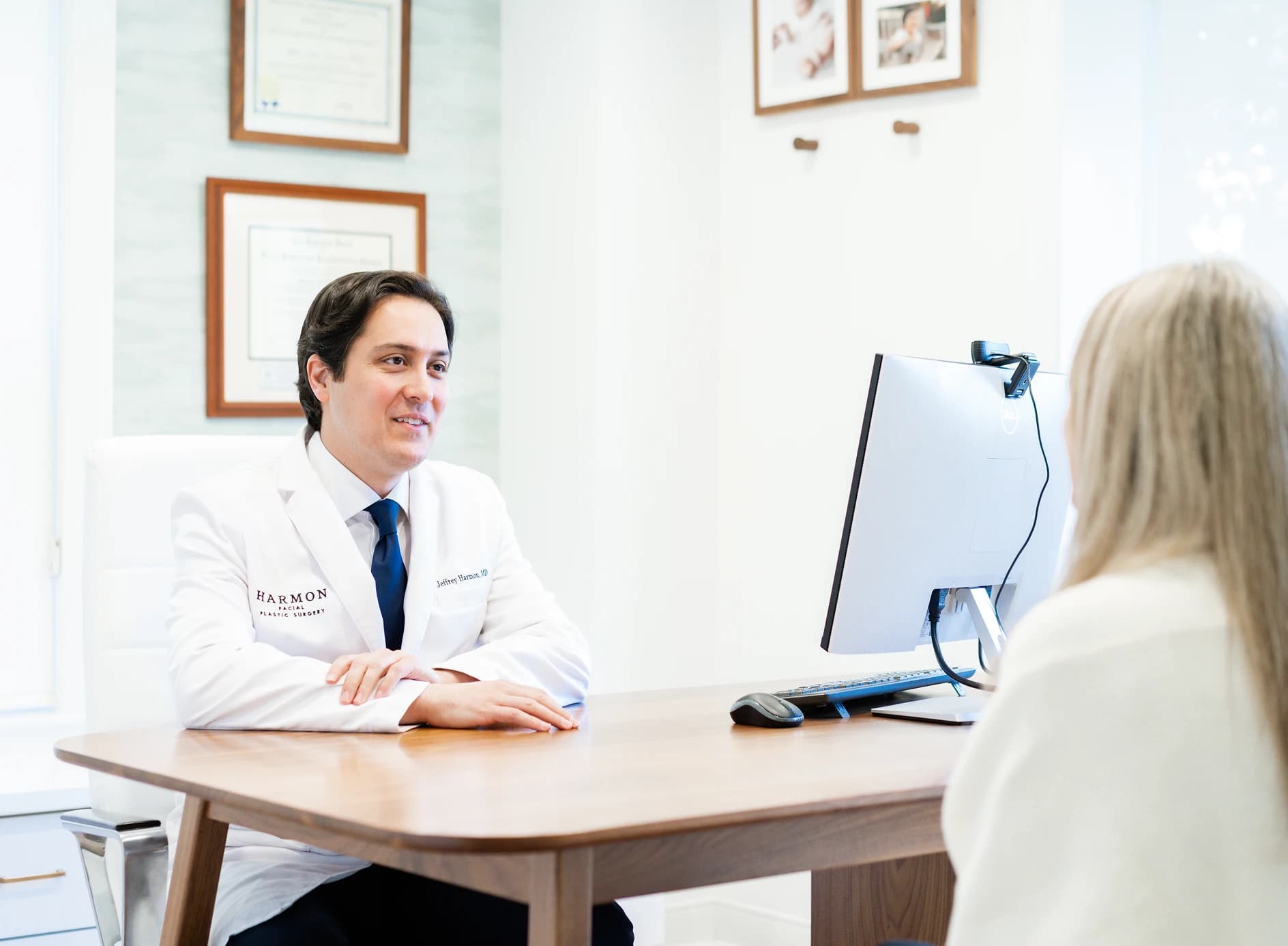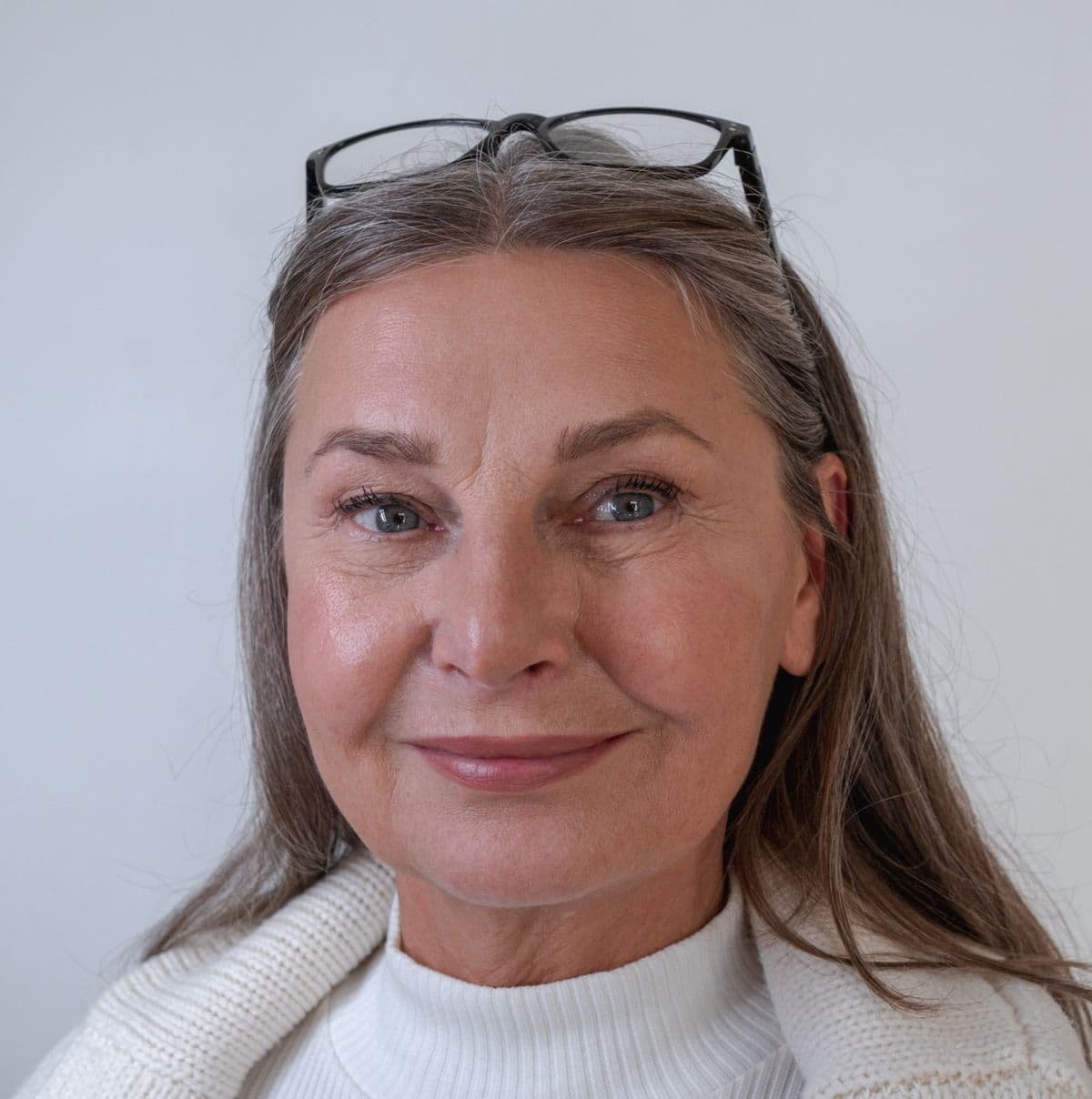Fillers
- Dr. Harmon can perform specialized blocks to decrease discomfort
- Dr. Harmon can inject some locations using a blunt-tipped microcannula rather than a needle, which can increase safety and decrease discomfort
Contact Us
What are Fillers?
Hyaluronic acid fillers, which include products from Galderma, Allergan, and other companies, are Food and Drug Administration (FDA) approved medications used for the purpose of adding volume to the face. And while fillers are most frequently placed in locations where they have been FDA approved, some locations where fillers are placed are considered FDA off-label.
Hyaluronic acid is a molecule produced in the human body. It absorbs water, serving as a cushion and lubricant. Hyaluronic acid fillers consist of laboratory-produced, human-modeled hyaluronic acid that is chemically crosslinked to create specific qualities, including more cohesiveness. Hyaluronic acid fillers appear as gels. These gels are injected under the skin at varying depths using a small needle or blunt-tipped microcannula.
The body contains an enzyme that breaks down hyaluronic acid, called hyaluronidase. Hyaluronidase acts on hyaluronic acid fillers, though more slowly than on the body's natural hyaluronic acid. In addition, an injectable form of hyaluronidase can be used to dissolve hyaluronic acid filler more quickly. Therefore, hyaluronic acid fillers are considered to be a temporary treatment, though the length of time products remain present in the body can vary considerably.
What Condition Does the Procedure Address?
Fillers help address poor volume in specific areas of the face or conditions that lead to volume loss in the face. Fillers can help address poor volume or volume loss in the following areas:
Cheeks that appear sunken due to age-related volume loss.
Temples that look hollow or concave.
A chin that appears recessed or lacks projection.
Tear troughs that create a tired or hollow under-eye appearance.
A jawline that lacks definition or appears saggy.
A nose with irregular contours that can be softened non-surgically, which is considered an FDA off-label use of these medications.
Lips that appear thin, asymmetrical, or lack definition.
Cheeks that appear sunken due to age-related volume loss.
Temples that look hollow or concave.
A chin that appears recessed or lacks projection.
Tear troughs that create a tired or hollow under-eye appearance.
A jawline that lacks definition or appears saggy.
A nose with irregular contours that can be softened non-surgically, which is considered an FDA off-label use of these medications.
Lips that appear thin, asymmetrical, or lack definition.
Before & After
Explore our galleries to see the stunning, natural results Dr. Harmon delivers.
Why Choose Dr. Harmon
The desire for youthfulness is understandable. There is no area more important than the face. After all, the face cannot be hidden. It is how we present ourselves to the world. Dr. Harmon works with a refined eye and trained hands to develop a personalized treatment plan with you, utilizing advanced techniques in surgical and non-surgical care of the face, nose, eyes, neck and hair.
Fellowship trained facial plastic surgeons have a unique specialized skill set in performing surgical and non-surgical procedures on the face, nose, eyes, neck and hair. The pathway to becoming a facial plastic surgeon begins with five years of rigorous training in head and neck surgery. This training is focused on all aspects of surgery for the head and neck, in addition to aesthetic and reconstructive procedures.
A small pool of top performing graduates from head and neck surgery programs are then selected to complete sub-specialty training as a fellow in facial plastic and reconstructive surgery through the American Academy of Facial Plastic and Reconstructive Surgery (AAFPRS).
Dr. Harmon completed his fellowship in facial plastic surgery through the AAFPRS with the world-renowned facial plastic surgeon Dr. Andrew Jacono on Park Avenue in New York City. Dr. Jacono is world renowned for developing the extended deep plane facelift technique. Dr. Harmon is one of the few surgeons in the world, and the only surgeon in the Cincinnati area, fellowship trained in this technique by Dr. Jacono.
Quad A Accredited Surgery Suite
Harmon Facial Plastic Surgery is proud to have a Quad A accredited operating room and facility in our office. Our single-physician, single-specialty facility meets or exceeds the strict guidelines and high standards set forth by Quad A, demonstrating our strong commitment to patient safety and excellence in surgical care. We utilize the services of board-certified anesthesiology physicians only as well as our own personal clinical support staff to ensure the most comfortable, safest experience for our clients.
Overview of the Procedure
The team at Harmon Facial Plastic Surgery works tirelessly to prepare patients well for their procedure. The time spent with patients and resources provided facilitates a smooth transition from the procedure through recovery. The following overview is a broad summary of the information provided to patients:
Procedure Consultation
Expect a detailed, informative discussion with Dr. Harmon about your concerns and aesthetic goals. He will develop a personalized treatment plan to address these concerns and goals.
Pre-Treatment Preparation
There is no specific pre-treatment preparation necessary prior to treatment with fillers. However, there may be some surgical or non-surgical treatments that could dictate the time frame in which fillers can be administered. It is also ideal to avoid blood thinning medications such as nonsteroidal anti-inflammatory drugs (NSAIDs) such as ibuprofen for one week prior to treatment.
Day of Treatment
It is ideal to arrive without makeup or other skin care products on the planned treatment sites. However, whether these products are in place or not, Dr. Harmon will clean the skin thoroughly prior to administering fillers.
Follow-Up Appointment
Dr. Harmon follows up with patients approximately two (2) weeks after their treatment with fillers.
Social Readiness
Patients are advised against massaging the treatment area for two (2) weeks after treatment. Some swelling is expected. Depending on the injection location, swelling usually improves significantly between one (1) and five (5) days after treatment. Bruises are possible. The risk of bruises depends on the site injected. Bruises usually improve significantly by five (5) to seven (7) days after treatment.
Ideal Candidates for Fillers
Ideal candidates for fillers include those patients who have poor volume or who have lost volume in their face. Most candidates for filler range in age from their twenties (20s) to their seventies (70s). Consultation is essential to determine candidacy for the procedure because there may be factors that preclude this procedure for certain individuals.
Reasonable expectations must be established about what fillers can and cannot accomplish as with all plastic surgery procedures.
Benefits of Fillers
Fillers are a method to temporarily increase volume in the face in an in-office, minimally invasive manner. The benefits of fillers include:
- Hyaluronic acid filler can be dissolved quickly by injecting hyaluronidase, if desired
- Hyaluronic acid filler can serve as a temporary trial prior to injecting fat in, for example, the temples and/or cheeks
- Hyaluronic acid filler can serve as a temporary trial prior to placing a more permanent chin implant
Risks of Fillers
The potential risks of fillers include, but are not limited to:
- Swelling
- Bruising
- Allergic reaction
- Occlusion of a blood vessel
- Scarring
- Migration of the medication to other areas
Combine Fillers with Other Facial Enhancements
Fillers complement other non-surgical and surgical facial plastic surgery procedures well. These procedures include, but are not limited to:
Deep plane facelift
A deep plane facelift lifts and repositions deeper facial structures, while fillers help fine-tune contours or enhance areas untouched by surgery, like the lips, temples, or tear troughs.
Brow lift
When paired with a brow lift, fillers can add softness and dimension to the temples or upper eyelids, helping achieve a more youthful upper face that looks lifted and well-rested from every angle.
Blepharoplasty
After eyelid surgery restores eyelid definition, fillers can help smooth under-eye hollows or subtly support the cheeks, blending transitions, and enhancing the overall brightness and vitality of the eye area.
Laser skin resurfacing
Laser treatments support skin tone and texture improvements, while fillers restore volume and shape. Together, they may address both surface and structural concerns for a more complete, natural-looking facial rejuvenation.
Botox©
Fillers restore lost volume, while Botox© relax expression lines. Combined, they help smooth and sculpt the face in a way that looks refreshed, never frozen.

Book Your Consultation
Take the first step toward your aesthetic goals with a personalized consultation. Dr. Harmon will listen to your concerns, answer your questions, and guide you through your options. Schedule your consultation today and discover how expert care can make a difference.
Read More About Fillers

Tear Trough Filler: An Explainer
Hyaluronic acid filler in the tear troughs can address specific concerns about the interface between the lower eyelid and cheek. It is important to...

What Qualities Distinguish Hyaluronic Acid Dermal Filler Products?
Hyaluronic acid dermal fillers can address specific concerns about flatness or poor volume in your face, including your temples, cheeks, tear...

How Could Non-Surgical Procedures Affect My Future Facelift and Neck Lift Surgery?
While often beneficial for their indicated use(s), non-surgical procedures, including injectables and energy-based devices (e.g., radiofrequency,...
FAQ
What is the best filler for my face?
Hyaluronic acid filler is a dermal filler product commonly used to add volume to the face. There are many hyaluronic acid filler options, each of which demonstrates different properties that make it more appropriate for one area of the face than the other. For example, Restylane Kysse© is appropriate for the lips while Restylane-L© or Restylane Silk© may be more appropriate for the tear troughs.
Is dermal filler a common non-surgical procedure?
Yes, hyaluronic acid dermal filler is a common non-surgical procedure. The International Society of Aesthetic Plastic Surgery (ISAPS) releases statistics each year that provide insight into the state of plastic surgery around the world. ISAPS reported 807,870 hyaluronic acid dermal filler non-surgical procedures were performed in the United States in 2020.
How long does a filler last?
A hyaluronic acid filler can last months to years depending on the product used and the location it is placed. For example, hyaluronic acid filler placed in the lips usually lasts for less time than hyaluronic acid filler placed in the tear troughs. Rarely, small volumes of hyaluronic acid filler are permanent unless treated with hyaluronidase, a medication that dissolves hyaluronic acid.
If I have hyaluronic acid filler in my face, does that prevent me from undergoing facial plastic surgery procedures?
No. The extended deep plane facelift, lip lift, brow lift (lateral temporal lift), eyelid surgery (blepharoplasty), and nose surgery (rhinoplasty) can all be performed on an individual with hyaluronic acid filler in their face. In fact, if desired, hyaluronic acid filler can be removed during the surgical procedure in some cases.
Who administers fillers at Harmon Facial Plastic Surgery?
Dr. Jeffrey Harmon administers all fillers himself. Dr. Harmon has the detailed understanding of facial anatomy and the experience as a fellowship-trained facial plastic surgeon to provide the safest, most effective treatment.
What type of anesthesia is required?
Dermal fillers can generally be placed comfortably with topical anesthesia with or without injected local anesthesia.
How can I prevent looking "overdone" with a filler?
Dr. Harmon has a detailed conversation with every patient about their aesthetic goals when administering a filler. All individual's aesthetic goals differ. As a result, the threshold at which a patient looks "overdone" may differ. A patient's unique anatomy and the total volume of hyaluronic acid filler used determine when this threshold is reached. Dr. Harmon guides patients through the process of administering a filler, sometimes cautioning against adding additional hyaluronic acid in order to prevent this threshold from being reached.
Written by Dr. Harmon
Discover the expertise and compassionate care of Dr. Jeff Harmon, a fellowship-trained facial plastic surgeon deeply rooted in the Cincinnati community. A former collegiate athlete and Cornell University graduate, Dr. Harmon brings discipline, precision, and a global perspective to his surgical practice—refined through elite fellowship training in New York City.
Located in Hyde Park, Harmon Facial Plastic Surgery proudly serves patients throughout the Cincinnati area offering personalized facial aesthetics with world-class skill and a hometown heart.